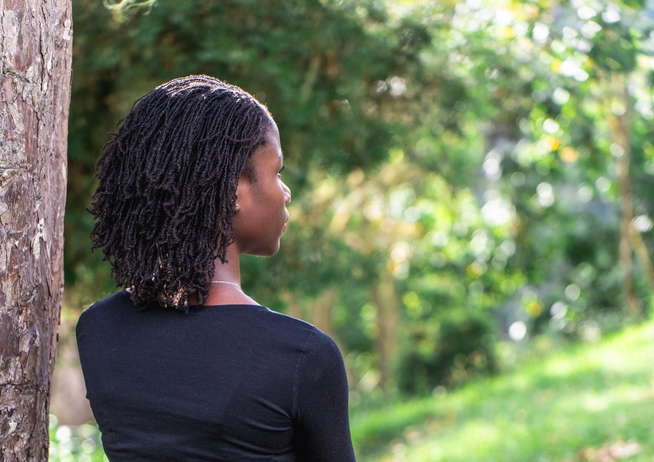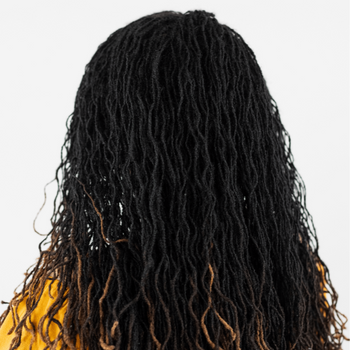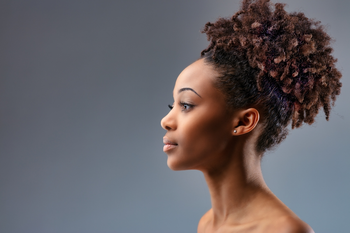

Here's a surprising fact - we lose between 50 and 100 strands of hair each day. This natural shedding can become a significant problem for individuals with thinning locs.
Everyone deals with thinning locs eventually. Tight, thinner dreadlocks increase your risk of traction alopecia in the long run. Traction alopecia is the primary reason locs start thinning. The numbers tell a clear story - half of all women see baldness by 50, while the situation affects four out of five men.
Your locs may thin due to stress, poor nutrition, or underlying health issues. The good news? You can fix most thinning loc problems with the proper care. The basics make a big difference - drinking enough water, eating healthy and balanced meals, and staying active help keep your hair strong naturally.
Let me share some expert tips to fix your thinning locs. You'll learn to spot early warning signs and get applicable information to bring your locs back to their best. These proven strategies will help save your locs, whether you notice slight thinning or face significant loss.
Table of Contents
Spotting the Early Signs of Thinning Locs
You can save months of frustration and potential hair loss by spotting the early warning signs of thinning locs. My daily work with locs has taught me that early detection significantly enhances recovery success.
Changes in Loc Thickness or Density
The first sign of thinning locs typically appears as noticeable changes in thickness or density. Your once-strong locs might start becoming thinner at certain points along the shaft. This doesn't happen overnight. Small, consistent stressors gradually wear down your hair's strength.
Watch for locs that look thinner compared to previous months. Take a good look at your entire head. Thinning in the middle section often points to nutritional deficiencies. The crown area might indicate different issues.
Breakage Near the Roots or Crown
Root-level breakage needs immediate attention. Weak spots often develop where your locs connect to your scalp, showing up as loose or weak roots. Mature locs' weight can strain hair follicles and cause inflammation. Your scalp might feel sore and itchy at the root area.
The crown area needs extra attention. A circular pattern of thinning that starts at the crown and moves outward could signal Central Centrifugal Cicatricial Alopecia (CCCA). Black women face this condition more often. CCCA damages hair follicles severely and replaces them with scar tissue, which prevents new growth.
Increased Shedding or Fallout
People naturally lose 50-100 hair strands each day. Excessive shedding looks different with locs. Many people believe that locs shed more than loose hair. The truth is that shed hair gets twisted into the locs instead of falling out during brushing.
Watch for intact locs on your pillow, floor, or coming off in your hand. Check your shower drain after washing. Some shedding is normal with locs, but big increases need attention.
Early detection guides you to better results. Regular self-checks of your locs help you spot and fix potential issues before they become severe.
Understanding the Root Causes
The first step to maintaining healthy locs is understanding why they're thinning. You need to identify the cause of the problem to treat it properly and prevent further damage.
Tension from Tight Styles or Retwisting
Tight styles are one of the main reasons locs become thin. Your edges are usually the first to show damage from pulled-back hairstyles. Regular retwisting pulls hair too close to the scalp, weakening the follicles. Hair experts warn that pain after visiting your loctician means the style is too tight. This constant pulling can cause your scalp to become sore and inflamed. It often results in traction alopecia, which causes most thinning dreadlocks.
Nutritional Deficiencies and Dehydration
Your body's health shows in your locs. Thinning in the middle of your head often points to poor nutrition. Low iron reduces oxygen to hair follicles and can hurt hair health. Your hair also needs zinc, biotin (Vitamin B7), vitamins C, D, E, and selenium to stay healthy. Water matters too - you should drink water equal to half your body weight in ounces each day to keep your locs growing strong.
Hormonal Changes and Postpartum Effects
Hormones play a significant role in maintaining the health of your locs. Pregnancy increases estradiol and progesterone levels that help hair grow. Three months after giving birth, these hormone levels drop sharply, and hair often falls out. Women going through menopause might see their hair thin permanently unless they start hormone replacement therapy. Other conditions like thyroid problems, PCOS, and high stress levels can disrupt normal hair growth.
Medication Side Effects
Many medicines can affect your hair follicles. Hair loss might happen if you take blood pressure medicines, antidepressants, heart medication, chemotherapy drugs, antibiotics, or some acne treatments. About 1-3% of patients taking methotrexate for rheumatoid arthritis lose hair. Leflunomide (Arava) affects about 10% of users.
Scalp Infections or Underlying Conditions
Scalp infections that aren't treated can block hair follicles and stop growth. Your locs might thin because of folliculitis, ringworm (tinea capitis), seborrheic dermatitis, or psoriasis. These conditions can leave permanent scars on your scalp and stop hair from growing back if you don't get the right treatment.
How to Repair Thinning Locs at the Root
Several proven techniques can rescue thinning locs and restore their strength. These expert methods target weak roots and prevent further damage.
Combine Weak Locs with Stronger Ones
Your severely thinning locs need immediate support from stronger neighboring locs. The two-strand twist method works best - just twist the weak loc with a stronger one and interlock them at the root. This technique saves weak locs from falling out and lets them fuse together naturally. You can combine two locs to make them slightly thicker. The thickness increases when you combine 3-6 locs, based on your size preference.
Wrap Loose Hair Around the Base
Loose hairs at the root happen often with wavy, curly, or fine hair textures. Let your hair dry first after shampooing. Then wrap those loose hairs around your loc's base before retwisting. This method strengthens the foundation without creating tension. Your new growth stays within the locs and those pesky flyaways remain under control.
Braid the Base to Add Aupport
Braiding creates structural integrity at weak roots. A stable foundation forms when you braid an odd number of locs together (3, 5, etc.). Braid patterns stay visible longer than twists. You might want to braid just the base while leaving the rest of the loc natural - this creates a more authentic look.
Use Thickening Oils like Jamaican Black Castor Oil
Jamaican Black Castor Oil stands out as the best choice to strengthen thinning locs. This special oil nourishes your scalp and promotes healthy follicles better than regular oils. Massage it into your roots and thinning sections twice each week. Box braids and other extension styles benefit from castor oil's ability to keep hair soft and moisturized for months.
Deep Condition Regularly to Strengthen Strands
Deep conditioning brings back moisture and strength to damaged locs. Monthly deep conditioning works better than weekly treatments because it prevents product buildup. Your scalp gets cleansed, dandruff stays away, and hydration returns. A 25-minute conditioning treatment after a clarifying wash delivers the best results.
Avoid Frequent Retwisting and Tight Styles
Constant retwisting weakens roots through traction. Stick to a moderate schedule - retwist every 4-6 weeks or interlock every 6-9 weeks. Tight ponytails, buns, and styles that pull your hairline need to go. Loose buns or braided updos spread tension evenly through your locs and protect them better.
When to Seek Professional Help
Self-care methods help with minor thinning, but you need to know when expert help becomes necessary to protect your precious locs from permanent damage. A professional can make all the difference between saving your hair and losing it forever.
Signs You Need a Dermatologist
You should see a dermatologist right away if you notice:
Bald spots, pain at the roots, or faster thinning
Your scalp feels sore, inflamed, or you're losing locs faster than usual
A receding hairline or widening part
Hair coming out in chunks
Circular patches of baldness
Blisters, bumps, flakes, or itchiness in thinning areas
Early detection guides you to better results, so don't wait until the damage becomes severe. Your stylist can help spot changes, especially in areas you can't easily see yourself, like the top of your scalp.
What to Expect During a Scalp Evaluation
Your dermatologist will:
Ask detailed questions about your hair loss timeline and patterns
Get into your scalp, nails, and other areas with hair loss
Test your hair's health through gentle pulling
Recommend blood tests or a scalp biopsy to learn why it happens
Make sure to prepare questions about possible causes, treatment options, and lifestyle changes that might help.
Medical treatments like minoxidil or PRP
Several effective medical treatments are available:
Minoxidil (Rogaine®): This treatment gets more and thus encourages more hair growth while preventing further loss. Results show up within 6-12 months of regular use
Platelet-Rich Plasma (PRP): This quick 10-minute procedure uses plasma from your blood injected into thinning areas. Many patients see less hair loss within months
Your specific condition might need steroids or antibiotics
Working with a Loctician for Repair Strategies
Among other medical treatments, experienced locticians provide specialized repair techniques:
Professional consultation to assess your locs' condition
Customized care plans based on your situation
Combining thinning locs with stronger adjacent ones when possible
Finding a loctician who knows how to work with thinning locs is vital. They understand both the beauty and health aspects of loc maintenance. The best results come from a team approach between your dermatologist and loctician to fix both the medical causes and physical repair of your thinning locs.
Conclusion
Your thinning locs require knowledge, care, and quick action to save them. This piece covers warning signs, damage patterns, and repair strategies for your locs.
Prevention is crucial. Monitor your loc thickness, check for root breakage, and watch for unusual shedding. Understanding the causes of damage—such as tight styles, nutrition, or hormonal changes—helps inform better care choices.
Practical repair solutions include combining weak locs with stronger ones and wrapping loose hair. Using thickening oils and proper conditioning can strengthen thinning locs. Avoid excessive retwisting and tight styles.
Seek professional help if needed. Dermatologists and locticians offer specialized treatments. Medical care with skilled maintenance works best for severe cases.
Your locs reflect your health and heritage. These strategies will help restore their strength through informed care.
Frequently Asked Questions
What are the early signs of thinning locs?
Early signs include changes in loc thickness or density, breakage near the roots or crown, and increased shedding or fallout. Regular self-checks can help identify these issues before they become severe.
How can I strengthen my thinning locs at home?
You can strengthen thinning locs by combining weak locs with stronger ones, wrapping loose hair around the base, using thickening oils like Jamaican Black Castor Oil, deep conditioning regularly, and avoiding frequent retwisting and tight styles.
What causes locs to thin?
Locs can thin due to various factors including tension from tight styles or retwisting, nutritional deficiencies, hormonal changes, medication side effects, and scalp infections or underlying conditions.
When should I seek professional help for my thinning locs?
Seek professional help if you notice bald spots, pain at the roots, rapid thinning, a sore or inflamed scalp, a receding hairline, or circular patches of baldness. Early detection and intervention often lead to better results.
Can thinning locs be repaired?
Yes, thinning locs can often be repaired through various techniques such as combining weak locs with stronger ones, proper care routines, and in some cases, medical treatments. Working with both a dermatologist and an experienced loctician can provide the best outcomes for severe thinning.




